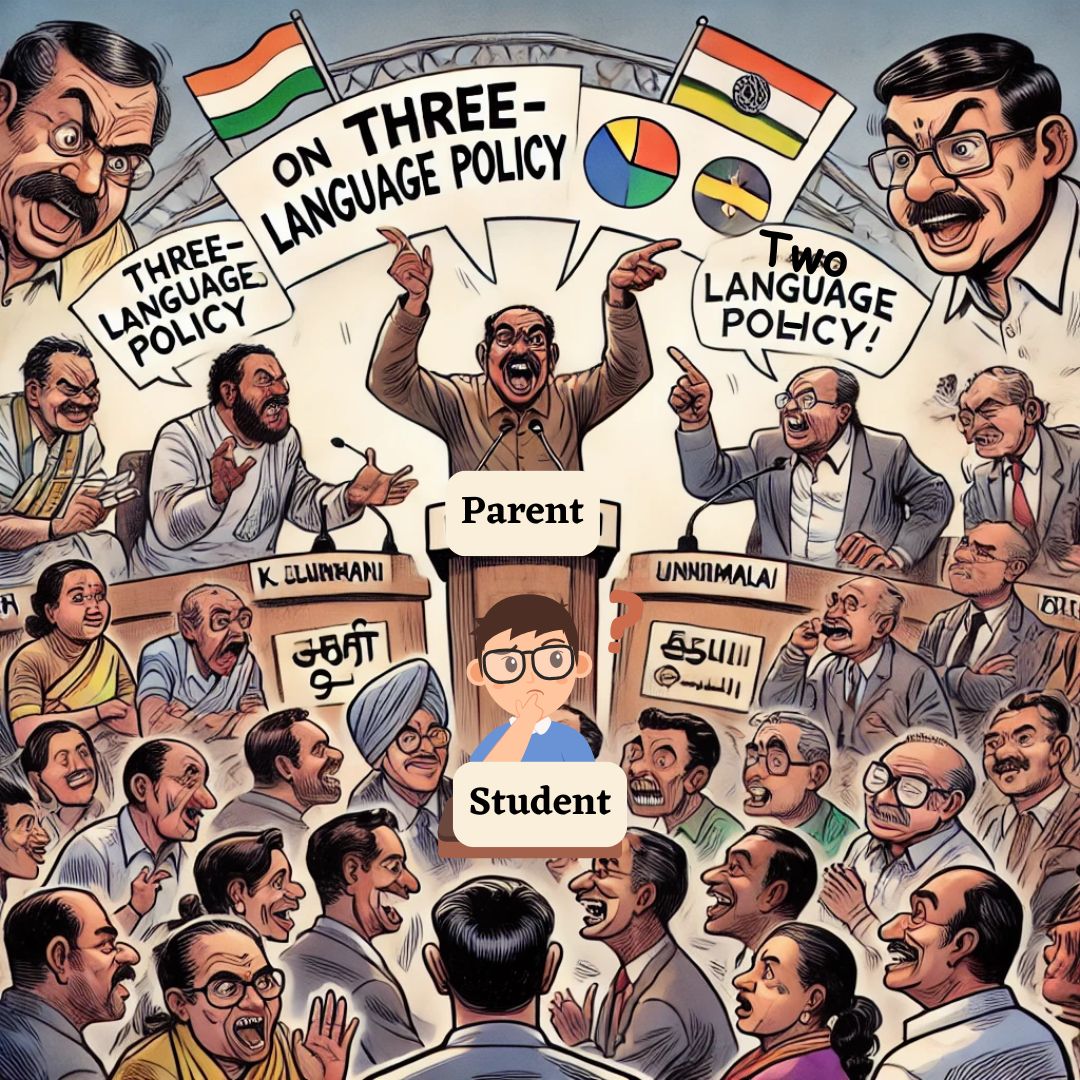by Dr E. Ramanathan PhD
The National Education Policy (NEP) 2020 of India introduced a three-language formula to promote multilingual learning and cultural integration while ensuring flexibility in language choice. The key aspects of the three-language formula under NEP 2020 are:
1. Medium of Instruction (Primary Level)
- Wherever possible, mother tongue/local language/regional language should be the medium of instruction at least until Grade 5, and preferably till Grade 8 and beyond.
- This is aimed at enhancing conceptual understanding and cognitive skills in young learners.
2. Three-Language Formula
- Students should learn three languages, with at least two being native to India.
- States, regions, and schools can choose the languages, ensuring that no language is imposed on anyone.
- The languages can include:
- The mother tongue or regional language (recommended)
- English (optional, but commonly chosen)
- A third language, which could be another Indian language or a foreign language.
3. Flexibility in Language Selection
- The choice of languages is left to the states, schools, and students, meaning there is no compulsory imposition of any language (such as Hindi or Sanskrit).
- This approach encourages multilingual proficiency while respecting linguistic diversity.
4. Sanskrit and Classical Languages
- Sanskrit is offered as an optional language at all levels.
- Other classical languages like Tamil, Telugu, Kannada, Malayalam, and Odia are encouraged.
- Foreign languages may also be introduced at the secondary level.
5. Implementation and Challenges
- States have different language policies, leading to regional variations in implementation.
- Some states, especially in the South and Northeast, are reluctant to adopt Hindi as one of the three languages.
- The availability of qualified teachers for all languages remains a challenge.
Objective and Benefits
- Encourages linguistic diversity and cultural exchange.
- Aims to improve cognitive abilities and communication skills.
- Strengthens national unity while preserving regional languages.
The policy emphasizes flexibility and does not enforce any specific language on students, ensuring a balanced approach to linguistic learning.
Refer the original document of NEP
Pros and Cons of the Three-Language Formula in NEP 2020
Pros:
- Promotes Multilingualism:
- Encourages students to learn multiple languages, improving cognitive skills and communication abilities.
- Enhances National Unity:
- Learning an additional Indian language fosters cultural integration and strengthens national identity.
- Preserves Regional and Indigenous Languages:
- The policy allows states to promote their native languages alongside Hindi and English, preventing linguistic erosion.
- Better Career Opportunities:
- Multilingual proficiency enhances job prospects in government, translation, diplomacy, and multinational companies.
- Cognitive and Intellectual Growth:
- Research shows that multilingual students have better memory, problem-solving skills, and creativity.
- Flexibility in Language Choice:
- The formula does not impose any specific language, leaving the choice to states and schools.
- Encourages Sanskrit and Classical Languages:
- NEP promotes the study of Sanskrit, Tamil, Telugu, Kannada, and other classical languages.
Cons:
- Implementation Challenges:
- Finding qualified teachers for all three languages in every state is difficult.
- Regional Language Conflicts:
- Some states, especially Tamil Nadu, oppose the introduction of Hindi, leading to resistance in implementation.
- Increased Academic Burden:
- Students may find learning three languages difficult alongside other subjects.
- Unequal Infrastructure in Schools:
- Many rural schools lack resources, teachers, and materials for teaching three languages effectively.
- Possible Language Imposition Concerns:
- Some states fear Hindi could be imposed indirectly, reducing the prominence of regional languages.
- Limited Scope for International Languages:
- While the policy allows foreign languages at the secondary level, the primary focus is on Indian languages, which may limit global exposure.
- State-wise Variability in Adoption:
- Different states may implement the policy differently, leading to inconsistencies across the country.
The three-language formula under NEP 2020 aims to balance national integration with linguistic diversity, but its success depends on effective implementation and regional acceptance.
Conclusion
Regardless of whether the education system follows a two-language or three-language policy, the focus should be on developing:
- Good Oral and Written Communication Skills – Clear expression, proper grammar, and fluency in the chosen language.
- Creative Writing Ability – Original thinking, storytelling, and structured composition.
- Presentation Skills – Effective articulation, confidence, and engaging delivery in both verbal and visual formats.
Mastery of these skills ensures academic and professional success, irrespective of the language policy in place. We should employ more communication experts schools and promote the presentation skills to our young children. Unfortunately, our school children are lagging much behind in communication skill even in their own mother tongue. Education should be freed from politicians.
Other Non-political Views
References
- https://www.education.gov.in/national-education-policy – National Educational Policy
- https://tnschools.gov.in/welcome Tamilnadu Schools
- https://kvsangathan.nic.in/en/ Kendriya Vidyalaya Schools
- https://www.cbse.gov.in/ CBSE Schools
- https://cisce.org/ ICSE Schools
- https://www.education.gov.in/ Government Education Website
- https://mospi.gov.in/ Ministry of Statistics and Program Implementation
- https://datatopics.worldbank.org/education/ Worldbank Education Statistics
- https://asercentre.org/aser-2024/ Annual Status of Education Report (ASER)
- https://swayam.gov.in/ Free online education system by Govt. of India



